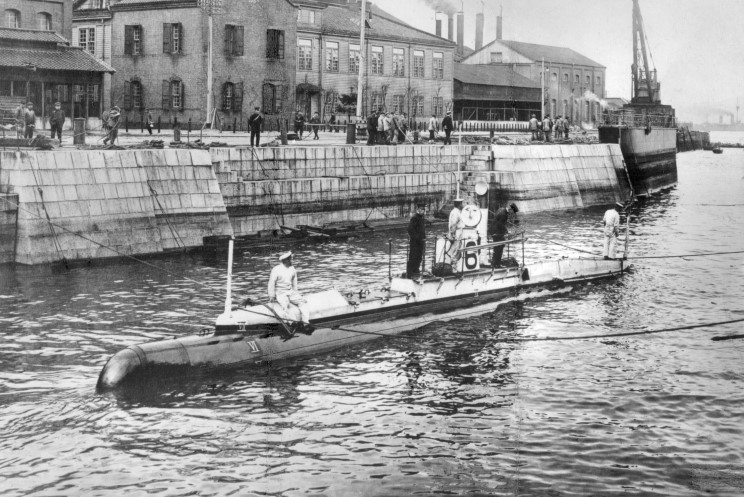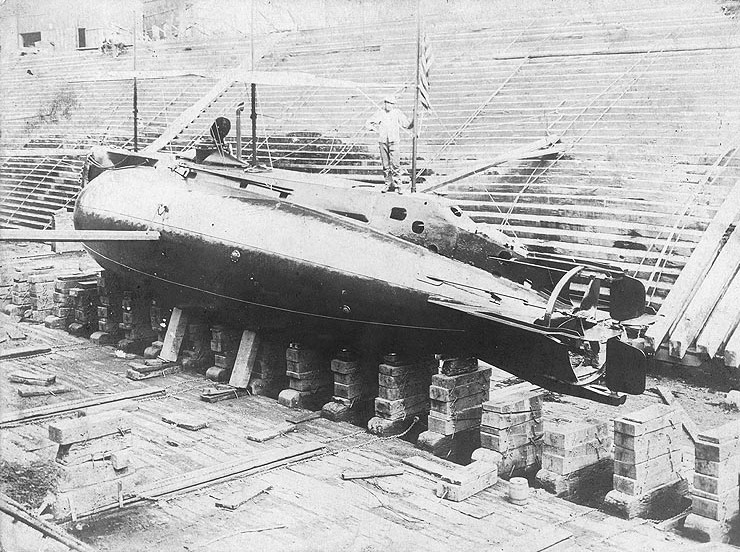|
April 15, 1910 the diving trials of Japan's first home built naval submarine were held in Kure harbor. Submarine #6 was built by Kawasaki at Kobe and was designed as a smaller version of the Holland type. The Japanese navy bought five of the Holland type submarines from the US and operated them successfully before deciding to build one of their own. The Holland submarine (SS-1) was only 63' long with a beam of 10'. While the Holland boat displaced 64 tons while surfaced, the Japanese boat, described as an experimental sub, displaced only 57 tons surfaced. They were both powered with a gasoline engine and of course a electric motor powered by batteries for operation underwater. The submarine, commanded by Lt. Commander Sakuma, and her 13 man crew set out in Hiroshima Bay and began the diving trials at 10:00 AM. The boat went under quicker than expected and a ventilator slide malfunctioned allowing the boat to flood. She sank stern first in 60 feet of water. By 11:00 when the boat failed to surface a signal was sent to the Kure Naval Base and rescue ships were dispatched to the scene. Several vessels made a frantic search for the lost boat but she was not located until the following afternoon. Difficulty with the lifting equipment delayed rescue even longer but, the boat was brought to the surface late that night. For the crew of Submarine #6 rescue came too late, all 14 had died from a combination of Co2 and gasoline fumes. However it was learned that they had been alive until just past noon on the 16th. While waiting for death Lt. Cmdr Sakuma wrote a detailed letter which was found when his body was removed from the submarine. His letter reads as follows; I am very sorry that, owing to my carelessness, I have sunk His Majesty's submarine and killed the officers and men under my orders; but I am glad that they have all faithfully discharged their duties with composure until the moment they died, and that we all sacrificed our lives for the sake of our country. What I fear, however, is that this mishap may cause public misunderstanding as to the safety of the submarine and check it's future development. If you, my dear sirs, investigate the development of the submarine with more zeal and without this misgiving I shall be most grateful. The cause of the sinking. While navigating under water with the gasoline engine we dived too deeply, and when we tried to close the slide valve of the ventilator the chain broke. Thereupon we endeavored to close it with our hands but it was to late, the after part of the boat being flooded, and she sank stern first. The angle was about 25°. After the boat had settled, her inclination was about 13°. As the switchboard was submerged the electric light went out and noxious gas issued which made breathing difficult. The boat sank about 10:00 AM on the 15th. We tried to pump out the water with a hand pump. No sooner had the boat sunk than we pumped out the main tank and although we could not see the gauge owing to the darkness we think we were successful. The electric current became unavailable, and although the solution in the cells overflowed a little, sea water did not get into them, which prevented the generation of chlorine gas. We depend upon the hand pumps entirely. The forgoing was written in the conning tower at 11:45 AM. The clothes of the crew are nearly all wet with salt water and they feel very cold. I am always of the opinion that the crew of a submarine must be very calm and careful, but unless they behave boldly the progress of the submarine will never be accomplished, and therefore I have always warned my men not to be too cautious through timidity. Some people may laugh at my failure on this occasion, but I am confident that I am right in my opinion. The depth gauge in the conning tower shows 52, and although we have done out best to pump out the water till noon the boat is still fixed. I think we must be in about 10 fathoms. The crew of a submarine should be composed of specially selected men least they should suffer similar experiences to this one. I am satisfied that my officers and men have all done their duty. Whenever I leave my home o join my boat I feel that I may never return alive, and therefore I have made my will and have left it in a drawer at my house, but it is not necessary to say more about it here as it only concerns my private affairs. I request that Messrs Taguchi and Asada will see my father about it. To His Majesty, Sire, I entreat you to look after the families of the officers and men under my orders so that they do not starve; this is the only thing that troubles me. Atmospheric pressure is increasing and I feel as if my eardrums have been broken. 12:30PM Respiration is extraordinarily difficult. I mean I am breathing petrol gas. I am intoxicated with petrol. Captain Nakano, it is 12:40... The letter abruptly ends there. This letter, an eerie testament to a dying crew is a rare example but by no means the only one of it's kind. You can read how the letter begins coherent and later becomes somewhat confused as the captain's brain starves for oxygen. It must have been a difficult task to write such a letter, in the dark and dying. The captain left us with an insight into the bravery and the peril submariners have faced since the submarine was invented.
|
© 2006 Michael W. Pocock MaritimeQuest.com |
 |
This may be the Submarine #6 from the story, the photo was taken in 1910 but the boat does not
|
 |
Holland SS-1
|